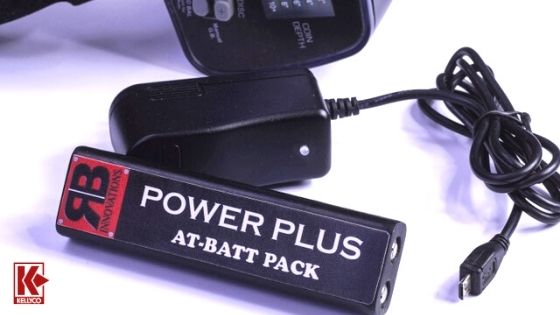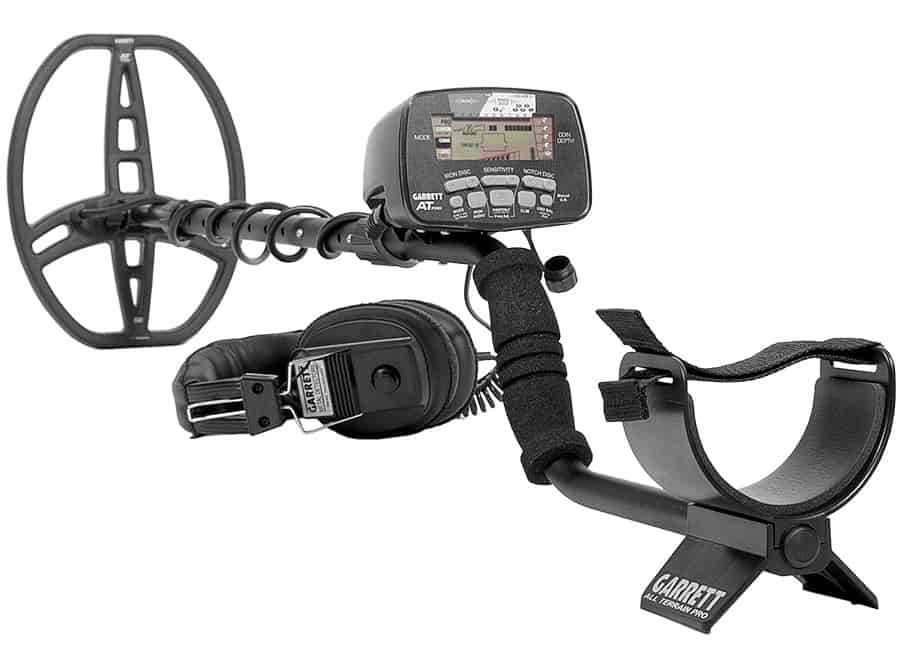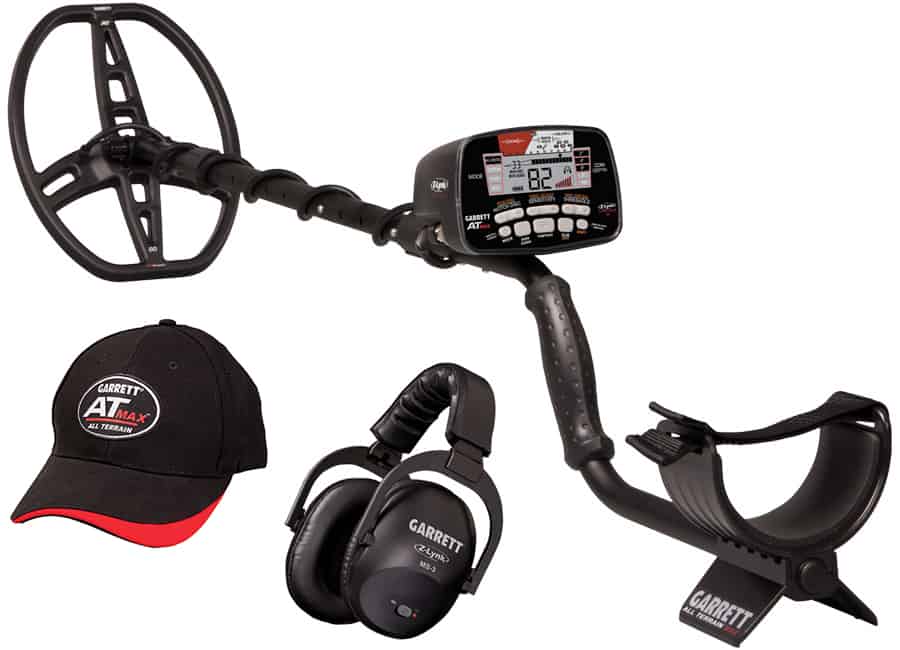Field Test: RNB Innovations Lithium Ion Battery with Charger Review (AT Pro / AT Gold / AT Max)
Published by Andy Sabisch on 08/06/19

AT Battery
Nearly 6 years ago, Garrett Metal Detectors introduced a metal detector that would be recognized as one of the milestones in detector design which over the years has included discrimination, ground balance, target ID, the “S-handle” and silent search. The detector which revolutionized not only their line but the industry as a whole was the Garrett AT Pro and it offered a wide range of features that provided above-average performance in a waterproof case that allowed hunters to search land and shallow water sites without requiring multiple detectors.
For the first time, a metal detector that offered visual target ID and depth information could be taken in water up to 10′ deep without fear of damaging the electronics. A year after the Garrett AT Pro was introduced, Garrett Metal Detectors brought out another model that used much of the same design but was focused on the electronic prospecting market… and it carried the appropriate name of the Garrett AT Gold.
The performance offered by both of these models along with their use in the popular National Geographic cable TV show, Diggers, has made the Garrett AT Pro and Garrett AT Gold two of the best-selling detectors around the world. In fact, the last time I was in Europe, nearly half of the detectorists I had the opportunity to meet were using one of these two models (or the Garrett AT Pro International).
While the AT models do an excellent job ferreting out lost treasure on land and in the water, the one thing that they all require is the power to operate, and that comes from the 4 AA Batteries held in the pack contained in the rear of the control housing. Batteries have come down in price and can often find packs at the register line when you check out of a discount store at bargain prices, you often get what you pay for.
I can tell you from personal experience that there is nothing worse than finally getting to a productive location, recovering a few targets, and then watching the detector turn off as the batteries die. Then unless you have another set with you, it’s off to a local convenience store to get more, and then you are usually paying a premium for what you need. At a recent club hunt, we had this very thing happen to a 14-year old that had received a Garrett AT Pro for Christmas. The batteries went dead, another club member had some with him that turned out to also be dead and his mother spent $8 at the local gas station for a set to get him up and running again. So where does that leave us? Well, that is the focus of this report I penned for the RNB Innovations Lithium Ion-Battery with Charger, specifically for the Garrett AT series.
In 2012 I got a call from Joe Cooper who started RNB Innovations and he discussed his vision for products he would be focusing on. He said that while detector technology had increased by leaps and bounds, battery technology used by the various manufacturers had stalled out in the 1980s. Ni-Cad and NiMH batteries were the norms if rechargeable packs were offered at all and the limitations that this technology had included reduced life after numerous recharge cycles, weight similar or in some cases more than conventional batteries, and limited run time between charges.
What Joe had noticed was that virtually any other rechargeable battery system out there such as those used on power tools, gardening equipment, RC cars, and a myriad of other items were of the lithium-ion polymer design, or abbreviated as LiPo. What he noticed when he delved into the LiPo technology was that they offered several advantages over other rechargeable technology. I summarized the benefits Joe shared with me in the report I did on his initial battery system but they are worth repeating here as they clearly show why Li-Ion batteries are superior to any other power source.
First, they weigh between 25% and 40% less than a comparable Ni-Cad or NiMH battery offering the same stored energy and while ounces may not seem worth mentioning, after swinging a detector for hours in the field, ounces can and will start to feel like pounds. Second, they don’t develop a memory that allows them to be “topped off” at any time including on the drive to a site with no impact on the amount of operating time they will provide. Third, they offer a more consistent discharge of power from the initial charge which provides for more operating life from a pack. Fourth, they can be fully recharged in a fraction of the time a Ni-Cad or NiMH pack requires and finally, they tend to hold a charge for months meaning you can pick up your detector after winter weather passes and be ready to go without worrying about looking for the charger.
A few years ago I took one of RNB Innovations LiPo battery packs to Germany with me for my White’s MXT and was able to hunt the entire time I was there without recharging the pack during the entire trip which really amazed me… and in fact, I was able to get even more time on the pack when I returned to the States before needing to charge it.
When I heard that Joe had developed a LiPo rechargeable pack for the Garrett AT Pro / Garrett AT Gold, I jumped at the chance to see how it would work in my Garrett AT Pro. The local club had several members that also used either the Garrett AT Pro or Garrett AT Gold which provided an opportunity to get additional feedback on the pack and its performance. Garrett’s literature for both models says that one should get between 20 and 40 hours on a set of AA batteries but actual operating life is typically in the 20-hour window. Even with buying AA batteries in bulk packages, if you are a serious hunter you can expect to be replacing them every week or two during hunting season and that cost can add up in short order.
The LiPo pack I received did not have the RNB Innovations graphics on it but the battery provided the same 2,200 mAh output as the production battery will have. Charging is a snap as it is with the other packs from RNB Innovations and it takes less than two hours to take on a full charge even if completely depleted. The pack has been designed to fit the Garrett AT Pro / Garrett AT Gold exactly so dropping the pack in and securing the cover was all that was required to be up running with the new battery system. I took the Garrett AT Pro out for several hunts and never had to recharge the pack.
To see how much run time remained, I left it turned on in the house checking it with a few targets every once in a while and it wasn’t until the following day that it finally ran out of power. Continuing to test it after a quick recharge netted me about 35 – 40 hours of operation which was considerably more than I had gotten before trying a wide range of AA alkaline and even lithium batteries. Feedback from club members who were Garrett AT Pro owners was overwhelmingly positive and everyone that saw the pack asked when they would be available as they wanted to pick one up and ditch the AA replacement cycle.
As I mentioned earlier, there is a slight weight advantage with the RNB Innovations pack as compared to AA batteries… and when you plan on spending hours in the field, any weight you can shed will be welcome as the day wears on!
The one piece of information worth noting is that the battery strength indication on any detector – including the Garrett AT Pro and Garrett AT Gold – will show a fully-charged pack when using Li-Ion batteries up until there are about 30 minutes or so remaining. Then the indication will drop quickly and the detector will power down. This is simply the way LiPo batteries discharge and is why it is recommended to recharge the pack every few trips or even on the way to/from the hunt site using the car charger. Remember, Li-Ion batteries do NOT develop a memory so keeping them fully charged will ensure you are always ready for hours of uninterrupted hunting when you get out in the field.
Garrett AT Pro
Like the more expensive CTX 3030, the Garrett AT Pro is fully submersible up to 10 feet. It’s an all-terrain detector that has 40 different discrimination settings to notch out various types of ferrous metals, including iron. Customers say this is one of the most versatile metal detectors out there. In the past, separate headphones were recommended, but with the upgraded MS-2 headphones you have all you need to get out detecting!
The Pro audio mode setting allows users to “hear” the properties of the target they have detected. It will emit a different tone depending on how deep an object is buried.
A digital target ID on the screen also allows users to quickly identify what the machine is detecting. The most ferrous targets are labeled between 1 and 40, with the most conductive targets — like thick silver — registering closer to 99.
Sometimes, when detecting, a larger ferrous target can be interpreted as non-ferrous (and therefore valuable). The AT Pro contains a feature called Iron Audio which, with the press of a button, can correctly identify the target.
- Weight: 3.03 pounds
- Frequency: 15 kHz
- Waterproof: Up to 10 feet
- Warranty: 2-year limited

- Waterproof up to 10 feet
- Easy to use
- Can be upgraded via Z-Lynk (Garrett’s proprietary wireless technology) for use with wireless headphones
- Limited depth and less than accurate reading in saltwater
- The Zero mode is not a true all-metal mode
- No backlight
- “I am a new first time user of a metal detector and after shopping around I decided on buying a Garrett AT Pro because of its versatility and easy to understand display. I like that it can be used in the water and is light enough to be used for hours at a time. After opening the box and getting right to detecting, I haven't been disappointed. The accessories that came with the AT Pro helped me in the field and the Relic Quest book was a very nice read. Thanks to Garrett for making such a quality machine.” - Christopher C.
Garrett AT Max
The Garrett AT Max is essentially a fusion of technology from Garrett’s AT Pro and AT Gold machines, combined with a number of enhancements. Operating at a slightly lower 13.6Khz operating frequency (compared to the AT Gold at 18Khz and AT Pro at 15Khz), the AT Max is optimized to shoot deeper and detect a wider range of target materials than its predecessors.

- Noticeable depth increase and ability to discern the tiniest of targets.
- The increased power combined with a manual/automatic 175-point ground balancing system also means that the Max is designed to handle a wide range of soil or water compositions.
- In terms of target detection and identification, the AT Max was relatively consistent. Interestingly, this was especially true on weak/uncertain targets if the coil was cocked at approximately a 30-45 degree angle while sweeping the target.
- The significantly increased RF transmit power and optimized micro-electronics of the Max mean the system operates much "hotter" than the Pro or Gold. This may require some additional fine-tuning of the sensitivity to avoid spurious tones.
- Required frequent ground balancing as well as sensitivity adjustments.
- The detector would occasionally become overloaded and have furious fits of rapid-fire beeps, squeaks and squawks which required a power down, restart and ground balance.
The AT Max was operated primarily in Zero Mode, no discrimination, with the sensitivity stepped back from the default to the fourth of the eight sensitivity LEDs. “All Metal” mode was also tested.
Garrett AT Pro
Like the more expensive CTX 3030, the Garrett AT Pro is fully submersible up to 10 feet. It’s an all-terrain detector that has 40 different discrimination settings to notch out various types of ferrous metals, including iron. Customers say this is one of the most versatile metal detectors out there. In the past, separate headphones were recommended, but with the upgraded MS-2 headphones you have all you need to get out detecting!
The Pro audio mode setting allows users to “hear” the properties of the target they have detected. It will emit a different tone depending on how deep an object is buried.
A digital target ID on the screen also allows users to quickly identify what the machine is detecting. The most ferrous targets are labeled between 1 and 40, with the most conductive targets — like thick silver — registering closer to 99.
Sometimes, when detecting, a larger ferrous target can be interpreted as non-ferrous (and therefore valuable). The AT Pro contains a feature called Iron Audio which, with the press of a button, can correctly identify the target.
- Weight: 3.03 pounds
- Frequency: 15 kHz
- Waterproof: Up to 10 feet
- Warranty: 2-year limited

- Waterproof up to 10 feet
- Easy to use
- Can be upgraded via Z-Lynk (Garrett’s proprietary wireless technology) for use with wireless headphones
- Limited depth and less than accurate reading in saltwater
- The Zero mode is not a true all-metal mode
- No backlight
- “I am a new first time user of a metal detector and after shopping around I decided on buying a Garrett AT Pro because of its versatility and easy to understand display. I like that it can be used in the water and is light enough to be used for hours at a time. After opening the box and getting right to detecting, I haven't been disappointed. The accessories that came with the AT Pro helped me in the field and the Relic Quest book was a very nice read. Thanks to Garrett for making such a quality machine.” - Christopher C.
